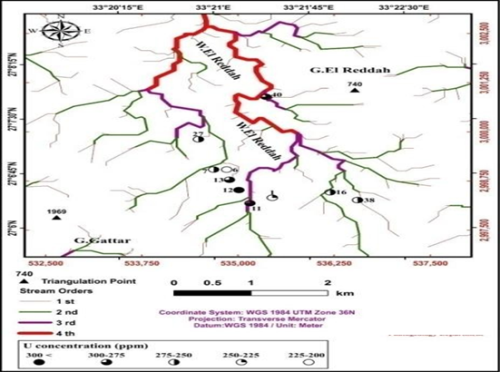
Stream Sediments Geochemical Exploration in Wadi El Reddah area, Northeastern Desert, Egypt
Abstract
Wadi El Reddah representing a semi-closed basin, extends in the N-S direction. It has only one outlet at the northern tip while the wadi collects floodwater from internal tributaries along wall rocks. The present study discusses the relationship between geology and geochemistry data to detect anomalous radioactive locations. The geochemical maps show the mineralization areas with abnormal rare metal contents. This led to two uranium occurrences (GXXIII and GXXIV) at Gabal Gattar in the perthitic leucogranite. At Wadi El Reddah, high contents of pathfinder elements (REE, Y, Zn, Nb and As) were discovered at the southern and eastern boundaries. This may be attributed to the presence of alkali feldspar granite at Gabal Gattar at the upstream of Wadi El Reddah and also to the sharp contact between Gabal Gattar and Hammamat Sedimentary rocks. A strong positive correlation coefficient between Fe2Ot and or Al2O3 with Zr, Hf, Nb, Ta, REE, U, Rb, and Th reflects their association with thematization processes.
Full Text:
PDFReferences
- H.V. Warren, R.E. Dellavault, Geochemical prospecting finds widespread application in British Colombia, Min. Eng., 1953, 5, 980-981.
- B. Berg, M.P. Berg, P. Bottner, E. Box, A. Breymeyer, R. Calvo de Anta, M. Couteaux, A. Escudero, A. Gallardo, W. Kratz, M. Madeira, Litter mass loss rates in pine forests of Europe and eastern United States: some relationships with climate and litter quality, Biogeochemistry, 1993, 20, 127–159.
- M.L. El Rakaiby, M.H. Shalaby, Geology of Gabal Gattar batholiths, central-eastern desert, Egypt. Int. j. Remote Sensing, 1988, 12,
-2347.
- F.W. Clarke, The relative abundance of the chemical elements, Bulletin of the Philosophical Society of Washington, 1889, 135–143.
- A. Levinson, Exploration Geochemistry, Applied Publishing, Wilmette, 1980.
- L. Gromet, R. Dymek, L. Haskin, R. Korotev, The North American shale composite: its compilation, major and trace element characteristics, Geochim. Cosmochim. Acta, 1984, 48, 2469–2482.
- R. Salminen, M.J. Batista, M. Bidovec, A. Demetriades, B. De Vivo, W. De Vos, M. Duris, A. Gilucis, V. Gregorauskiene, J. Halamic, P. Heitzmann, Geochemical Atlas of Europe, Part 1 Background Information, Methodology and Maps, Geological Survey of Finland, Otamedia Oy, Espoo, 2005, 525.
- K. Vrynioti, D. Alexakis, G. Bathrellos, H. Skilodimou, D. Vryniotis, E. Vassiliades, D. Gamvroula, Distribution of trace elements in stream sediments of Arta plain (western Hellas): The influence ofgeomorphological parameters, J. Geochem. Explor., 2013, 134, 17–26.
- F. Ramadan, S. El Balakssy, O. Amer, Mineralogical and geochemical characteristics of the miocene-quaternary sedimentary formations, Wadi Wizr-Wadi Sharm El-Bahari Area, Central Eastern Desert, Egypt. Jour. Sediment., 2013, 82.
- O.A. Ebyan, H.A. Khamis, A.R. Baghdady, M.G. El-Feky, N.S. Abed, Low-temperature alteration of uranium–thorium bearing minerals and its significance in neoformation of radioactive minerals in stream sediments of Wadi El-Reddah, North Eastern Desert, Egypt, Acta Geochim., 2020, 39, 96-115.
- S.J. Ekwere, Li, F and Rb contents and Ba/Rb and Rb/Sr ratios as indicators of post-magmatic alteration and mineralization in the granitic rocks of the Banke and Ririwai younger granite complexes, North Nigeria, Mineral. Deposita, 1985, 20, 89-93.
DOI: http://dx.doi.org/10.13171/mjc10802011021539st
Refbacks
Copyright (c) 2020 Mediterranean Journal of Chemistry
